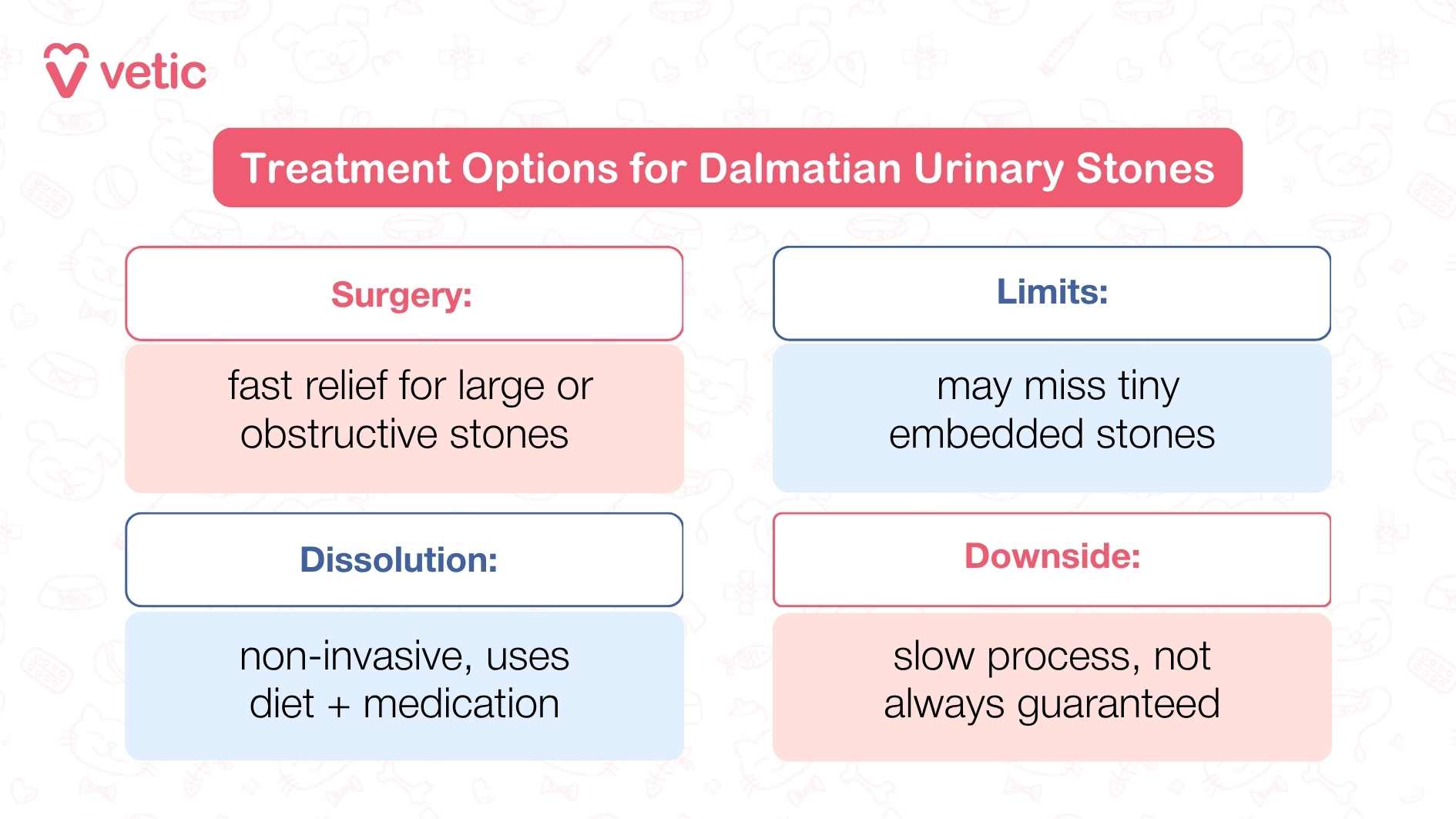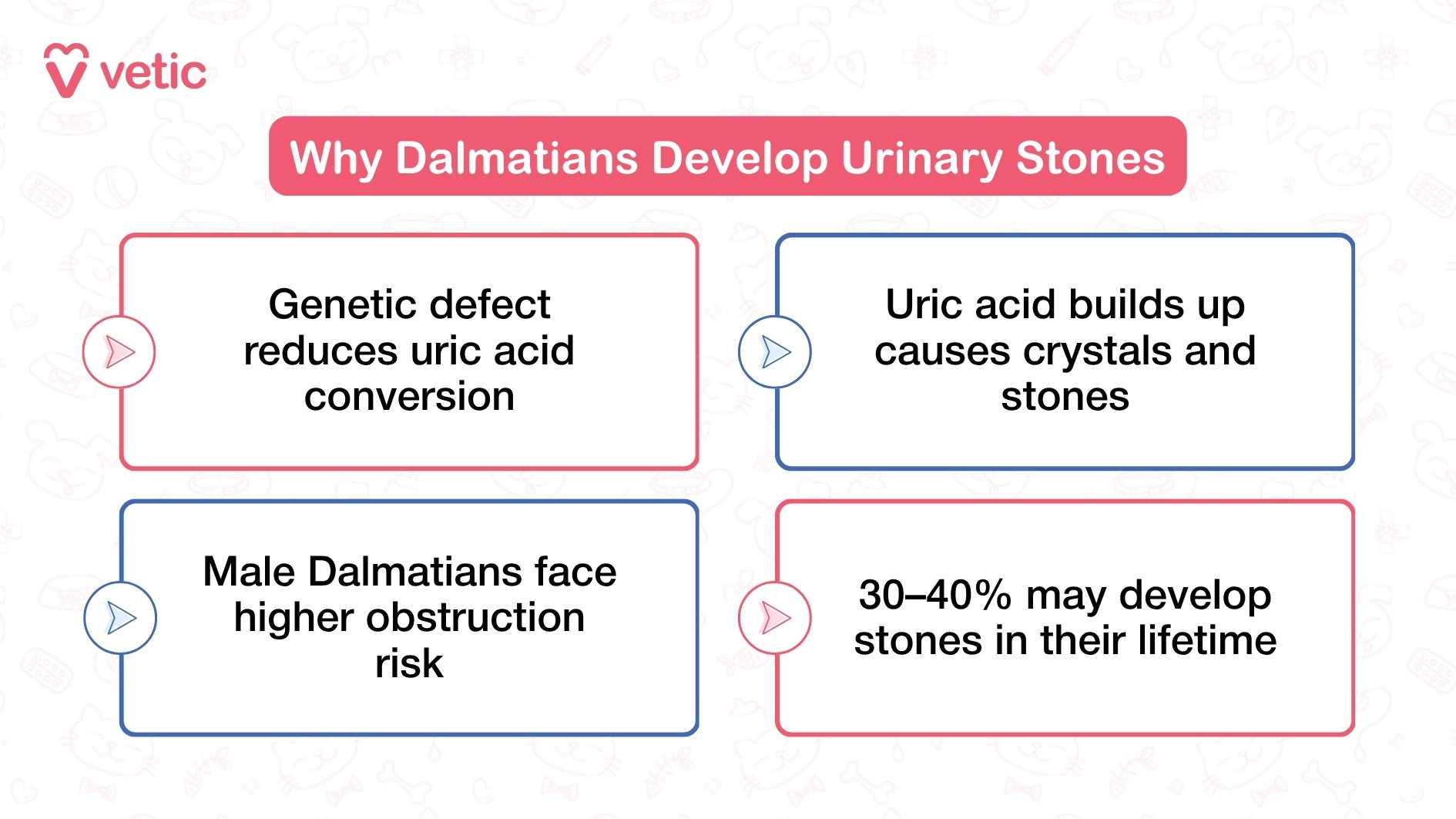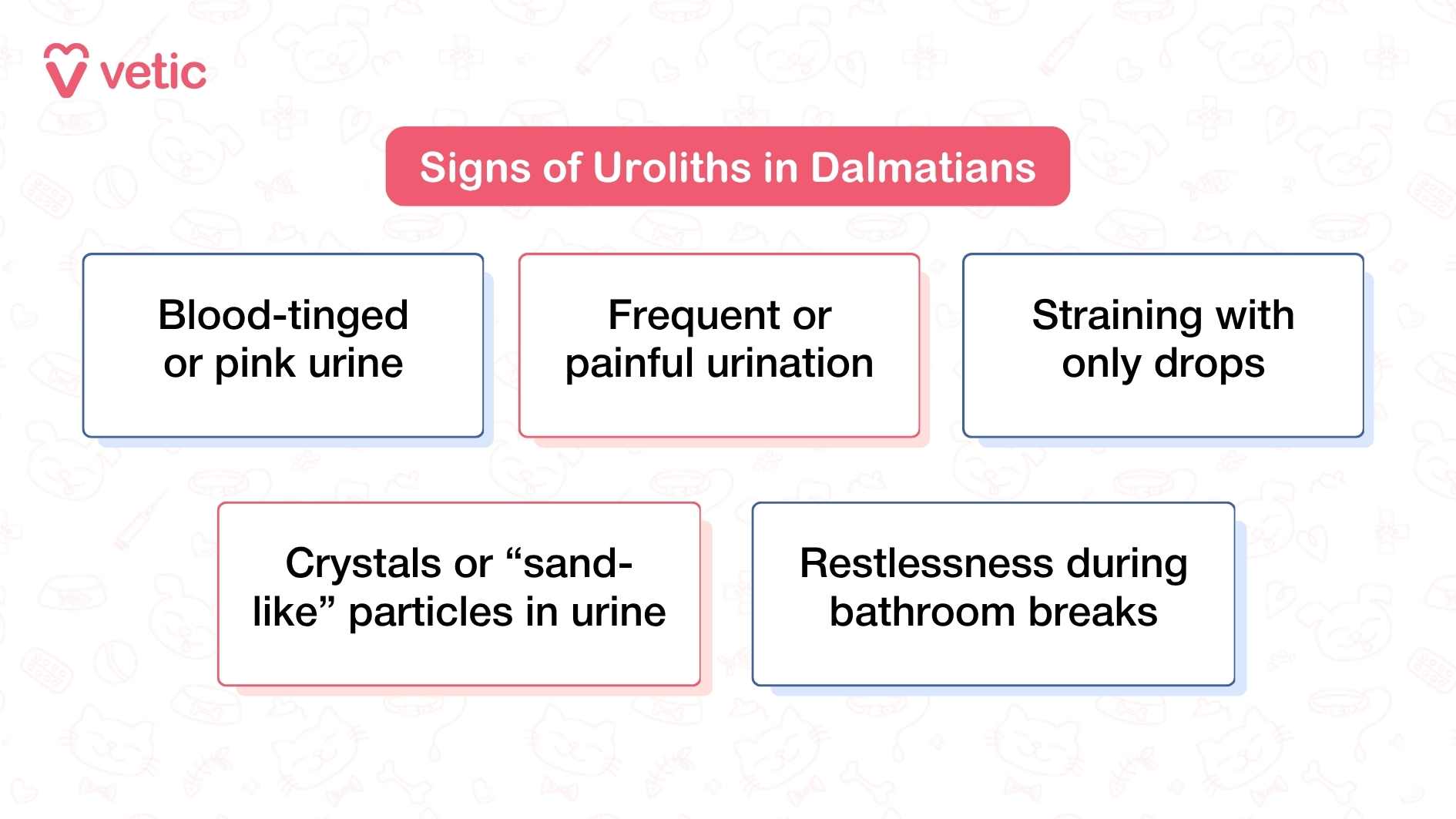Spotty coats aren’t the only thing that make Dalmatians unique. This breed carries a genetic trait that affects how their body processes uric acid, making them one of the most stone-prone dog breeds in the world.
If you’ve ever wondered why urinary stones in Dalmatians are so common, why some dogs develop them early, or how you can protect your own Dalmatian from painful urinary issues, this guide explains everything clearly and compassionately.
For Dalmatian parents, early awareness is the key to preventing serious urinary problems and recognising warning signs before they turn into emergencies.
Formation of Uric Acid Stones (Uroliths) in Dalmatians
Uric acid stones form when the body cannot efficiently process and eliminate purines — compounds found naturally in many foods, especially meat.
Most dog breeds effortlessly convert uric acid into allantoin, a harmless substance that dissolves in urine and passes out of the system. Dalmatians, however, have a defect in this metabolic pathway, causing uric acid to build up in their urine instead of dissolving.
Over time, this concentrated uric acid crystallises. Crystals collect, layer over each other, and eventually form stones in the bladder, urethra, or even the ureters.
This inherited metabolic difference is the reason Dalmatians account for roughly 80% of all uric acid urinary stones reported in dogs worldwide.
Are All Dalmatians At Risk of Developing Uric Acid Stones or Urolithiasis?
All purebred Dalmatians have some degree of impaired uric acid metabolism. But not all will form stones.
The underlying genetic mutation (involving reduced uricase enzyme activity and transport abnormalities in the liver) exists in every Dalmatian. What varies is the extent to which this defect affects each dog.
Why Dalmatians Are Genetically Prone to Developing Uric Acid Stones
Some Dalmatians excrete extremely high levels of uric acid, while others maintain moderately elevated levels without ever forming stones. Lifestyle, diet, hydration, and concurrent illnesses can influence the likelihood of stone formation but genetics remain the core factor.
Male Dalmatians face significantly higher risk because their urethra is narrower and more easily obstructed. The average age for diagnosis is around four to five years, although young adults and seniors can also be affected.
What Are the Signs of Uroliths in Dalmatians?
For many Dalmatian parents, the first warning sign is a change in urination habits. Your dog may begin straining, taking longer to pee, or urinating in frequent small amounts. Some dogs become visibly uncomfortable when attempting to urinate, shifting their weight or looking back at their abdomen as if confused by the sensation.
One of the most alarming signs is the appearance of bloody urine, a common indicator of bladder irritation or stone movement.
You might also notice tiny crystals or “sand-like” granules in the urine – an early clue that mineral buildup is beginning.
These subtle shifts are easy to overlook, which is why Dalmatian parents should never ignore a change in bathroom behaviour. Early intervention can prevent blockages and protect the urinary tract from damage.
Diagnosis of Uroliths in Dalmatians
Because uric acid stones are radiolucent, they often do not appear on a plain X-ray. A Dalmatian showing urinary issues may therefore need more advanced imaging.
Veterinarians commonly use contrast radiography or ultrasound to detect stones and identify whether they are lodged in the bladder, urethra, or higher in the urinary tract.
It is also perfectly normal for Dalmatians to show uric acid crystals in their urinalysis. This finding does not confirm stones on its own, nor does a high uric acid level guarantee the presence of stones.
Diagnosis is a combination of symptoms, imaging, and veterinary assessment.
Treatment for Uroliths in Dalmatians
Treatment depends entirely on where the stones are located, whether they are causing obstruction, and how large or numerous they are. In some dogs, stones accumulate silently for months. In others, a single stone shifts into the urethra and creates an immediate medical emergency.
Surgical Treatment for Bladder Stones (Uroliths) in Dogs
Surgery is still the most direct and reliable method for removing larger bladder stones or stones that are causing a blockage. During surgery, the bladder is opened, stones are removed, and samples are sent for analysis since Dalmatians may occasionally form struvite or oxalate stones as well.
Surgery provides quick relief but comes with limitations. It is invasive, cannot always remove every tiny embedded stone, and does not prevent new stones from forming. Because Dalmatians tend to form multiple stones, recurrences can happen even after successful surgery.

Medical Dissolution of Uroliths in Dalmatians
For dogs who are not in danger of obstruction, dissolution offers a non-invasive alternative. This method relies heavily on strict dietary adjustments, medication, and careful urine monitoring. A low-purine diet paired with allopurinol helps dissolve uric acid stones gradually by reducing the uric acid concentration in the urine.
However, dissolution requires patience. It may take three to four months, demands routine tests, and carries the risk that a dissolving stone can shift into the urethra — especially in male dogs. Despite these challenges, it remains a highly valuable option for older dogs or those who cannot undergo anesthesia.
Emergency Care for Urinary Obstruction in Dalmatians

A complete urinary blockage is a life-threatening emergency. Because male Dalmatians have a naturally narrow urethra, they are especially vulnerable to sudden obstruction when a stone travels into the urethral passage.
A blocked dog may repeatedly attempt to urinate without producing more than a few drops. They may cry, pace, lick themselves excessively, or appear extremely restless. Some dogs become nauseous or collapse from pain.
Never wait to “see if it improves.”
A urinary obstruction can cause kidney damage and electrolyte imbalance within hours.

Diet for Uroliths in Dalmatians
Diet is the most powerful tool for preventing Dalmatian stone problems. Because purines are the root cause of uric acid buildup, a low-purine diet reduces strain on the urinary system.
Veterinarians often recommend prescription urinary diets designed to dilute urine and reduce uric acid formation. Increasing moisture in meals, using wet food, and encouraging water intake through fountains help maintain healthier, more diluted urine.
While meat-based proteins are limited, safe options exist. Foods such as egg, cottage cheese, certain fruits, and whole grains without yeast can supplement low-purine diets. Equally important is avoiding high-purine foods like organ meats, red meats, sardines, and yeast-rich treats.

Prevention and Recurrence After Stone Removal
Even after successful treatment, Dalmatians remain genetically predisposed. Prevention is therefore a lifelong commitment. This includes staying on a veterinarian-recommended urinary diet, monitoring urine pH, ensuring steady hydration, and returning for regular urinalysis and imaging. Periodic liver and kidney function tests may also be recommended, particularly for dogs on long-term allopurinol.
With consistent monitoring, many Dalmatians go years without another episode and some never have a recurrence at all.
Caring for a Dalmatian means understanding their unique metabolic needs. While Dalmatian urinary stones can be serious, early recognition, proper nutrition, timely treatment, and routine veterinary care dramatically improve outcomes. Most Dalmatians with well-managed urinary health live long, active, joyful lives.
FAQs
1. Why are Dalmatians so prone to urinary stones?
Dalmatians have a genetic defect that prevents normal uric acid metabolism. This leads to higher uric acid in urine, making Dalmatian urinary stones far more common than in other breeds.
2. What early signs suggest my Dalmatian may have bladder or urethral stones?
Blood in urine, straining, frequent urination, and discomfort during bathroom breaks often indicate Dalmatian urinary issues and should be evaluated by a vet immediately.
3. Can diet really help prevent urinary stones in Dalmatians?
Yes. A low-purine, hydration-rich diet reduces uric acid buildup and supports long-term urinary health, especially in dogs with recurring Dalmatian stone problems.
4. Are male Dalmatians at higher risk of urinary obstruction?
Male Dalmatians have narrower urethras, making them more likely to experience life-threatening blockages when stones form or move—especially in cases of Dalmatian UTIs or inflammation.
5. Does bloody urine always mean my Dalmatian has stones?
Not always, but Dalmatian bloody urine is a red-flag symptom. It may indicate stones, infection, or irritation and requires prompt veterinary assessment.
6. How long does it take to dissolve uric acid stones in Dalmatians?
Stone dissolution can take three to four months of strict diet, medication, and regular monitoring. Success varies, but it’s a valuable alternative to surgery for many dogs.
7. Can urinary stones come back after removal?
Yes. Because the underlying metabolic defect remains, recurrence is common. Regular urine checks, a lifelong urinary diet, and good hydration help prevent future Dalmatian urinary stones.



